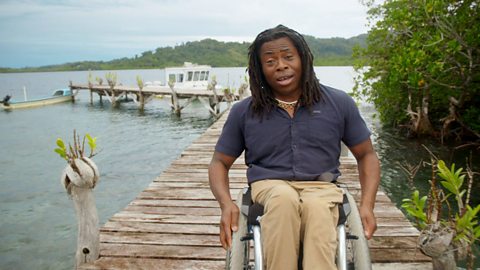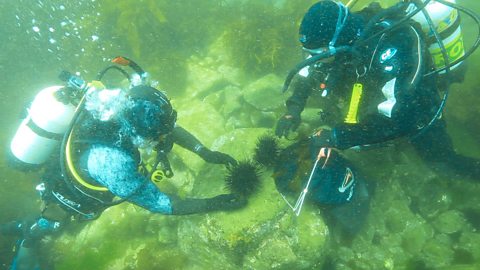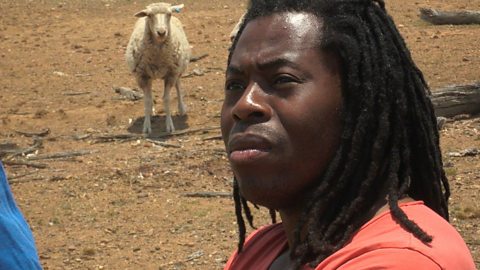Ade Adepitan visits a wind farm in Tasmania that will help the island to reach a major milestone: producing all of its electricity from renewable sources.
ADE: Hi, my name’s Ade and I’m here in Tasmania. It’s a beautiful, rugged island off the south coast of Australia and it’s pretty exposed to the elements so it gets lots of wind and rain which makes it perfect for generating renewable energy.
Look at this. It’s huge, it’s taking up the whole skyline. And listen to the sound of the blades.
Wind power is simple, but effective. The wind turns the blades of a turbine around a rotor which spins a generator, making electricity. The kinetic energy of the spinning blades is converted into electrical energy.I was visiting when this wind farm was still under construction. The plan was to have 48 turbines powering more than 60,000 homes. John Titchen was showing me round.
Ah, you've picked a good place for a wind farm, I'd don't even have to push my chair. It's lovely.
JOHN TITCHEN: Excellent! You're going with no effort!
ADE: No effort. And this is uphill as well.
JOHN TITCHEN: So here we have got a crane assembling a turbine. Next step is to assemble the blades on the hub and lift that up.
ADE: There's movement! Time to shift. It's moving quicker than I thought it would. Oh it's still moving. It's following me. John, lots of technical equipment here but it also looks like some good old-fashioned legwork going on as well.
JOHN TITCHEN: Yeah, bit of arm work really.
ADE: With all Tasmania’s other green energy plants, this wind farm will enable the island to reach a major milestone: producing all of its electricity from renewable sources, and it’s not stopping there.
JOHN TITCHEN: There's a cable across from Tasmania which is an island across to the mainland. So we can export power to the rest of Australia.
ADE: So you’ll be able to call Tasmania the powerhouse of Australia?
JOHN TITCHEN: Yeah. The renewable energy powerhouse I’d say.
ADE: Looks like it’s a good job done yeah? It’s all in?
JOHN TITCHEN: Yeah, all in.
ADE: This island has been an exciting glimpse of what we can do if we put our minds to it. The question is whether we can do what Tasmania’s doing - and more - across the entire planet.
Video summary
Ade Adepitan visits a wind farm in Tasmania that will help the island to reach a major milestone: producing all of its electricity from renewable sources.
Tasmania is exposed to the elements so its climate makes it perfect for generating renewable energy. Wind power is simple, but effective. The wind turns the blades of a turbine around a rotor which spins a generator, making electricity. The kinetic energy of the spinning blades is converted into electrical energy.
This clip is from the Â鶹Éç Two series Climate change: Ade on the frontline.
Teacher Notes
Before watching the film
The film develops students’ understanding of energy sources and renewable energy, focusing on what wind power can achieve. Wind turbines have attracted some controversy and can divide opinion so it may be useful to find out existing preconceptions and misconceptions about them first.
Has anyone got a wind turbine near where they live? What do you think about them? What do students know about them? You could separate out responses into fact and opinion. If there are any misconceptions in the responses, you could indicate this but not say what they are at this point. Returning to what students have said at the outset may be more effective after watching the film.
During the film
With this short film, it may be useful to pose the opening question about existing knowledge and opinions first. Then watch the entire film through without a break, asking students to report afterwards. This would be a good point for challenging misconceptions and identifying useful and purposeful enquiry questions with students;
- What do we now know about wind power?
- Is everyone confident identifying renewable and non-renewable sources of energy, for example?
- Do we know why this is a good place for wind turbines and what factors generally make a place attractive for turbine installation?
- What are the pros and cons of renewable energy from wind power? Does this vary from place to place? Why?
- What would be the best questions to ask to create a case study?
Following on from the film
Establish locational context.Use maps and globes to establish where the island of Tasmania is. Research and add data showing location of renewable power plants.
You could research and use weather and climate data to note the direction and power of prevailing winds around Tasmania and use this as part of a case study report. Identify how this place is using its natural resources sustainably and who benefits.
This example in the film is of 48 turbines powering more than 60,000 homes. To get an idea of this students might map their local area to show a similar number of homes.
How have places in other parts of the world used their natural resources in sustainable ways to harness energy sustainably? This might be in the UK or could be part of a regional comparison at KS3, for example comparing a location within Africa and Asia.
Examine the pros and cons of a local sustainable energy project. Where are the best places for wind / tidal and geothermal energy in the UK and why?
This short film is suitable for teaching KS3 and KS4 students. It can be used alongside the other Ade Adepitan films about climate change or watched on its own. All the films build on students’ understanding of climate change issues and enable them to make global connections.
This film supports the KS3 geography curriculum by investigating our changing climate and how human and physical processes interact to influence and change landscapes and environments.
At KS4, the film supports understanding about managing resources in sustainable ways and the importance of conserving natural resources for future generations (CCEA). The film supports students’ understanding of energy sources and how different countries have the potential to exploit different amounts and types of energy. It could also support work developing case studies thinking about sustainable resource management (Edexcel).
This clip could be used to support the delivery of geography to KS3 and KS4 students. Specifically, this topic appears in OCR, Edexcel, AQA, WJEC KS4/GCSE in England and Wales, CCEA GCSE in Northern Ireland and SQA National 4/5 in Scotland.
Sea level rises in the Solomon Islands. video
Ade Adepitan travels to the Solomon Islands to see the dramatic effect rising sea levels are having on local communities.

Kelp reforestation in Tasmania. video
Ade Adepitan travels to Tasmania to find out about the work being done to protect the carbon-capturing underwater kelp forests.

Drought in Queensland, Australia. video
Ade Adepitan visits Queensland, where drought has had a devastating effect on the landscape.

Reducing food waste in Sydney, Australia. video
Ade Adepitan visits Sydney to learn about an organisation that redistributes food that would otherwise be wasted.
